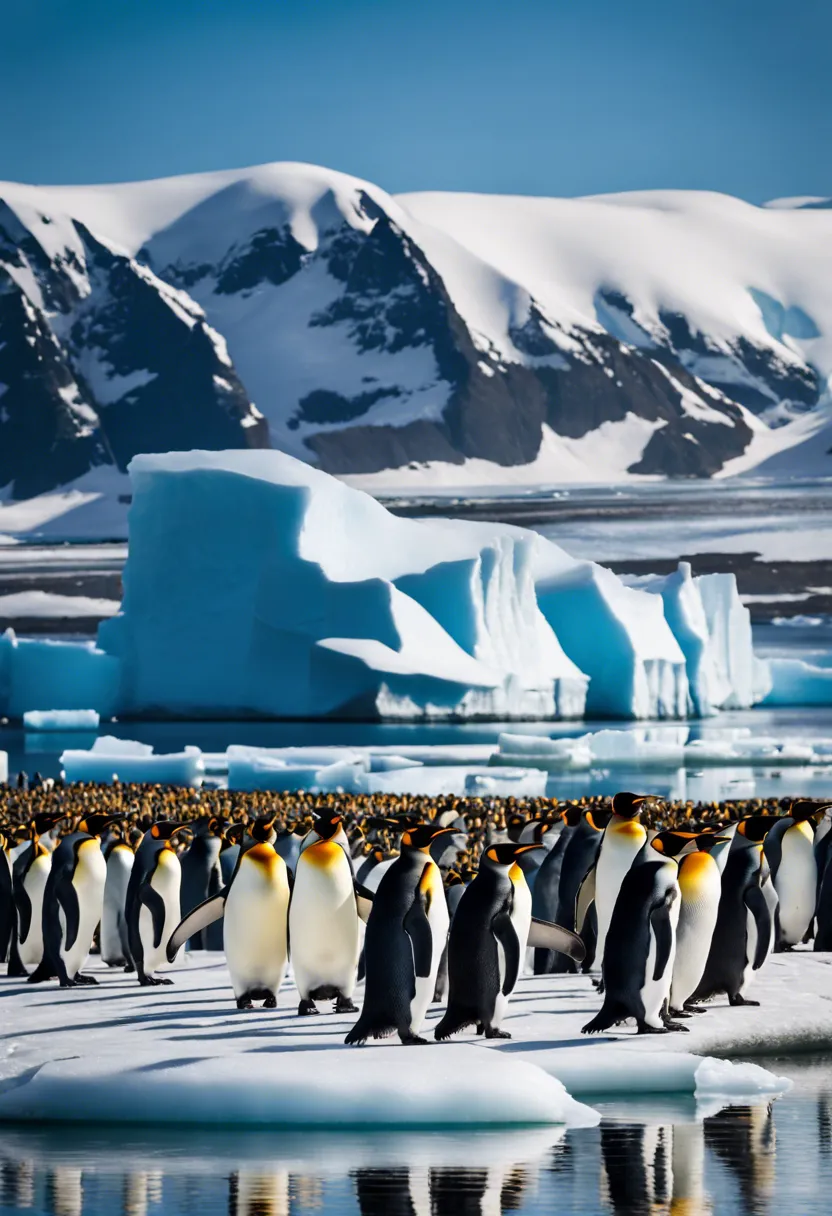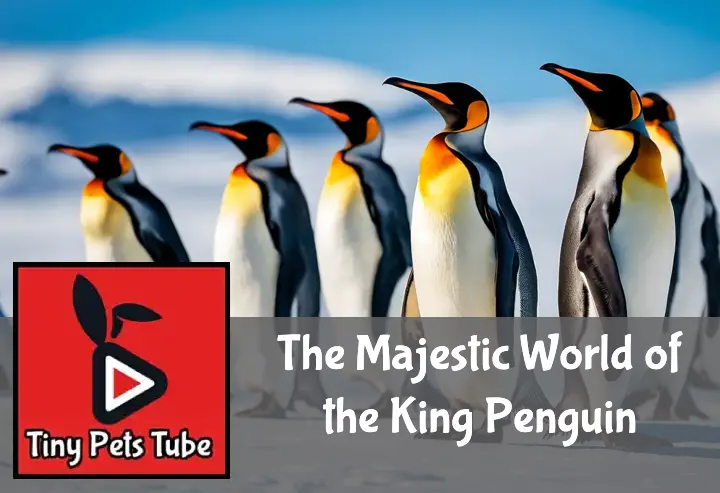Ever watched a documentary and been utterly captivated by the sight of an elegant, regal bird strutting its stuff on the Antarctic ice? That’s right, I’m talking about the King Penguin. They’re like the James Bond of the penguin world – smooth, suave and just a little bit cheeky.
In this blog post, we’ll take a deep dive into their majestic world. From their quirky mating rituals to their uncanny ability to survive in some of the harshest conditions on Earth – there’s more to these tuxedoed titans than meets the eye! So buckle up, it’s going to be one heck of a waddle! Keep reading about The Majestic World of the King Penguin.
Key Takeaways
- King Penguins are the second largest species of penguin, known for their vibrant colors and majestic stature.
- They inhabit sub-Antarctic islands and waters, where they feed on small fish and squid.
- King Penguins have a unique breeding cycle that lasts over a year, with both parents sharing incubation duties.
- Their population is currently stable but threatened by climate change and industrial fishing.
- Conservation efforts are ongoing to protect their habitats and ensure the survival of this remarkable species.

What are King Penguins?
Meet the King Penguin, a majestic member of the Antarctic wildlife. This bird is a unique species in the penguin taxonomy, boasting distinct physical characteristics and an interesting lifespan. We’re about to dive deeper into these aspects, so buckle up!
The Taxonomy of King Penguins
The King Penguin belongs to the family Aptenodytes, sharing its genus with only one other species – the Emperor Penguin. Scientifically known as Aptenodytes patagonicus, this bird holds a special place in penguin classification.
Unlike their relatives who prefer icy terrains, King Penguins have adapted to sub-Antarctic climates. They’re like the cool cousins of Antarctic birds, literally! Their differentiation from other species isn’t just climate-based; it’s also evident in their behavior and breeding patterns.
Physical Characteristics of King Penguins
When it comes to size, King Penguins stand tall – second only to their Emperor cousins. A typical penguin size comparison would reveal that our Kings are among the largest of all penguins.
Their feather patterns are quite distinctive too. Sporting sleek black backs and bellies whiter than fresh snowfall, they wear a splash of sunset-orange on their necks like an exclusive fashion statement among Antarctic animals.
But what sets them apart is their unique adaptation as aquatic birds. Their long bodies and strong flippers make them excellent divers and swimmers – true kings of Antarctic waters!
Lifespan and Health of King Penguins
In terms of lifespan expectancy, King Penguins can live up to 20-30 years in the wild – quite impressive for penguins! However, like every other creature in the animal kingdom, they face certain health challenges.
In both wild and captivity settings, diseases can pose threats to these birds’ health. While veterinary care helps manage such issues in captive breeding environments, natural predators impact their health in the wild.
Despite these challenges, King Penguins play a crucial role in maintaining the Antarctic ecosystem balance. Their survival and health are not just about them – it’s about preserving an entire world of icy wonder!
Where do King Penguins Live?
The world of the King Penguin is as majestic as it is diverse. These regal birds have carved out a life in some of the most inhospitable regions on Earth, their survival intricately linked with their unique habitats. From the icy expanses of the Antarctic to remote sub-Antarctic islands, they’ve turned challenging environments into thriving breeding grounds, a testament to their resilience and adaptability.
Geographic Distribution of King Penguins
When you think about where King Penguins hang out, your mind probably jumps straight to Antarctica. And you’re not wrong! These penguins are indeed residents of this frosty continent. But did you know they also inhabit several sub-Antarctic islands? Places like South Georgia Island and the Falkland Islands are prime real estate for these tuxedoed tenants.
Their distribution range isn’t just limited to these chilly locales though. Penguin colonies have been spotted on other islands scattered throughout the Southern Ocean. It’s like they’re playing a game of ‘find the coldest spot on Earth’ and winning!
Habitat Preferences of King Penguins
Now, let’s talk about what makes a place feel like home for a King Penguin. They’re pretty picky when it comes to choosing their breeding sites. Coastal areas with easy access to marine ecosystems are top picks for these birds.
But it’s not just about location; temperature plays a big role too. Too hot or too cold, and it’s a no-go zone for our feathered friends. They prefer places that offer just enough chill without turning into an ice cube.
Their habitat preferences directly influence their lifestyle, especially when it comes to feeding habits. Being near water means easy access to food – think all-you-can-eat seafood buffet! So next time you’re feeling adventurous and decide to visit one of these remote places, don’t forget to pack your warmest clothes and a sense of awe for the majestic world of the King Penguin.

What is the Life Cycle of a King Penguin?

The life cycle of a king penguin is an enchanting journey, filled with unique rituals and fascinating growth stages. From the moment an egg is laid, to the time it becomes a mature adult, every stage in the king penguin lifecycle is a testament to nature’s marvels.
Mating and Breeding Habits
When it comes to love, king penguins don’t mess around. Their courtship displays are as elaborate as they come. The mating season behaviors involve intricate dances and vocal exchanges that would put any Broadway musical to shame!
But it doesn’t stop there. These birds are also expert builders. They create nests using pebbles and feathers, ensuring their future offspring have a cozy place to start life. This attention to detail plays a crucial role in their reproductive success, making them one of the most successful breeders among Antarctic wildlife.
Incubation and Chick Rearing
After all that dancing and nest building, it’s time for some serious parenting. The incubation period for king penguin eggs lasts around 55 days, during which both parents share duties equally – talk about gender equality!
Once hatched, chick rearing begins in earnest. Both mom and dad take turns feeding their fluffy bundle of joy until it’s ready to fledge – usually after about 14-16 months. This high level of parental investment is key in ensuring the survival of these adorable creatures amidst harsh Antarctic conditions.
Growth and Maturity
Growing up isn’t easy – even for king penguins! After fledging, chicks embark on their journey towards adulthood. They face numerous challenges during this phase but thanks to their survival strategies, they manage just fine.
Key growth milestones include molting (shedding old feathers for new ones) and learning how to hunt independently. By overcoming these adolescent challenges, they eventually reach maturity in king penguins and are ready to start the cycle all over again. It’s a tough world out there in the Antarctic, but these resilient birds sure know how to thrive!
How do King Penguins Behave?
The King Penguin behavior is a fascinating blend of social interactions, communication methods, and survival strategies. These elements weave together to form the complex tapestry of their daily lives in some of the world’s harshest environments.
Social Structure and Behavior
Now, let’s talk about the social dynamics among these waddling wonders. The King Penguin group behavior is all about teamwork. They live in large colonies where everyone has a role to play. From finding food to protecting each other, it’s all hands (or should I say flippers?) on deck.
Their social interactions in penguins are crucial for survival and breeding. It’s not just about who can slide on their belly the fastest or who has the shiniest feathers. No siree! It’s more like a soap opera with intricate penguin colony hierarchy and elaborate breeding rituals.
Communication Methods Amongst King Penguins
Communication amongst these feathered fellas goes way beyond simple squawks and honks. They use a combination of vocalizations and body language to keep their social bonds strong.
The sounds they make aren’t just noise; they’re King Penguin calls, unique identifiers that help them recognize family members amidst thousands of similar-looking buddies. And when it comes to feeding time, well, let’s just say their coordination would put synchronized swimmers to shame!
Predators and Defense Mechanisms
Life isn’t always easy for our tuxedo-clad friends though. They have predators lurking both on land and sea. But fear not! These birds have developed some pretty nifty defense strategies in penguins.
When faced with threats, they don’t just sit around waiting for trouble; they take action! Their survival tactics against predators involve everything from forming protective circles around their chicks to using their sharp beaks as weapons if need be.
So, next time you see a King Penguin, remember there’s more to them than meets the eye. They’re not just cute and cuddly; they’re survivors, thriving in some of the most challenging conditions on Earth!
What do King Penguins Eat?
When it comes to the King Penguin diet, these Antarctic residents are not fussy eaters. They feast on a variety of Antarctic marine life, making them an integral part of the ecosystem.
Diet Composition
The main components of their diet include krill, various fish species, and squid. Krill consumption is particularly high during certain seasons when these tiny crustaceans swarm in abundance. The types of fish species in the penguin diet can vary based on availability, but lanternfish are often a favorite.
In addition to fish and krill, squid in the Antarctic diet also play a significant role. These slippery creatures provide essential nutrients that cater to the nutritional needs of king penguins. Interestingly, there are noticeable seasonal dietary changes among these birds. They tend to consume more squid and fish during winter months when krill are less abundant.
Hunting Techniques
Now let’s dive into how these majestic birds catch their food. The hunting strategies employed by King Penguins are nothing short of impressive! Their ability to reach incredible diving depths for feeding is one such strategy. Some have been known to plunge over 300 meters deep in pursuit of prey!
They also employ what could be termed as “group hunting strategies“. By hunting in groups, they can herd schools of fish or swarms of krill together, making it easier for each bird to snag a meal.
Their underwater speed is another advantage. With speeds reaching up to 12 km/hour, few prey stand a chance against the swift and agile King Penguin. And don’t forget about their keen eyesight! Their excellent visual abilities allow them to spot potential meals from afar.
Lastly, they have developed unique prey detection methods, which involve sensing vibrations and movements in the water through their feathers! This sensory adaptation further enhances their hunting efficiency and success rate.
Why are King Penguins Important to the Ecosystem?
The King Penguin’s ecosystem importance cannot be overstated. These regal birds play a pivotal role in maintaining Antarctic biodiversity, contributing significantly to the marine food chain and impacting local species. Their ecological impact is profound, making them vital for biodiversity conservation.
Role in the Food Chain
When it comes to the Antarctic food web, King Penguins are key players. They primarily munch on small fish and squid, keeping these populations in check. But they’re not just diners; they’re dinner too! Seals and killer whales consider them a tasty treat, which helps keep those predator populations healthy.
This balance of eat-and-be-eaten is what keeps our ecosystems ticking along smoothly. The King Penguin’s diet and their position as both predator and prey contribute significantly to this ecosystem balance. So next time you see a penguin chowing down on some squid, remember – they’re doing their part for Mother Nature!
Impact on Local Biodiversity
Now let’s talk about how these tuxedoed fellas influence local biodiversity. By existing and eating (two things penguins are pretty darn good at), they affect other Antarctic species in significant ways.
Their feeding habits help control fish and squid populations, preventing overpopulation that could disrupt the delicate ecological balance. This is one way that penguins fill an important ecological niche.
But it’s not all about eating! Just by being there, penguins create habitat sharing benefits for other creatures like seals or birds who might use their nesting areas when they’re off fishing. It’s like a timeshare – but with more feathers!
So whether it’s through their dining choices or simply hanging out, King Penguins play a big role in shaping the Antarctic landscape and its inhabitants’ lives. They truly are the kings of their castle…or should we say iceberg?
What Threats do King Penguins Face?
Life’s not always a beach party for our tuxedo-clad friends, the king penguins. They’re up against a slew of threats, both natural and man-made.
Natural Threats
First off, let’s talk about the big bad wolves in their world – the natural predators. These guys have to watch their backs for hungry seals and birds of prey. And then there’s the environmental challenges. Climate change is throwing a major wrench in their lifestyle, messing with their Antarctic habitat and causing food scarcity in their diet.
But wait, there’s more! As if dealing with predators wasn’t enough, these poor fellas also have to grapple with some serious environmental challenges. We’re talking unpredictable weather patterns and melting ice caps here folks!
Human-Induced Threats
Moving on to the dark side of human activities harming king penguins. Pollution effects on penguins are no joke – oil spills can be downright deadly for these birds. Overfishing is another biggie that’s messing with king penguin food sources.
And let’s not forget about tourism threats to Antarctic wildlife. Sure, we all love a good selfie with a penguin, but too much human interaction can stress out these little guys.
Conservation Status and Efforts
So where does this leave our feathered friends? Well, they’re currently listed as ‘least concern’ on the conservation status scale. But don’t let that fool you – they still need our help!
There are global efforts to save king penguins, including protected areas for them and wildlife protection laws for Antarctic species. Plus, there are research projects on king penguins aimed at understanding their needs better.
In short, it’s high time we stepped up our game to ensure these majestic creatures continue to waddle around Antarctica for generations to come!

To Wrap Up
We’ve journeyed through the icy realms of the King Penguin, discovering their regal ways and quirky behaviors. These tuxedo-clad monarchs of the Antarctic are as fascinating as they are adorable.
So next time you’re chilling on your couch, remember these frosty fellas braving the cold and living life king-size. Let’s do our bit to protect their majestic world.


